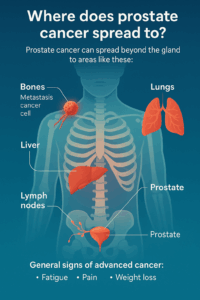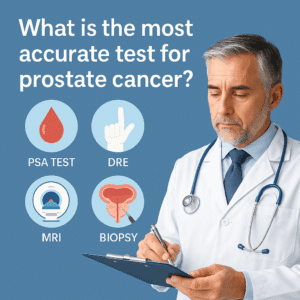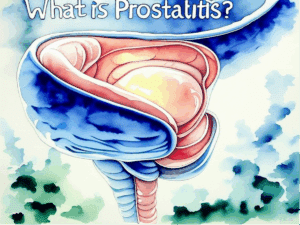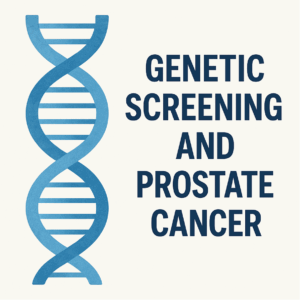Understanding your Gleason score
When investigating prostate cancer, there are many tests conducted that can help doctors detect the presence, size, aggressiveness, and location of a tumour.
Some tools used to help stage prostate cancer include evaluating your Gleason score.

“I wish I’d have known them. A PSA test, the Gleason score, the stage of the cancer. These are magic words that I would recommend people actually use around the physicians they see”
Ray Braithwaite
The Focal Therapy Clinic patient
Gleason score
The Gleason score (often now called your Grade Group) is used to evaluate how aggressive your cancer is and how likely it is to spread beyond your prostate. The Grade Group allows your prostate cells to be graded on a scale from 1 to 5. At 1, you have healthy normal cells. At 5, they are mutated so much they barely resemble ‘normal’ cells.
Your Gleason score is calculated using the formula:
Gleason score = The most common grade + the highest other grade in the sample
Your pathologist will look at your biopsy sample and will assign one Gleason grade to the most common type in your biopsy. The second Gleason grade is the second most common type in the same biopsy.
If you are found to have prostate cancer, your Gleason score will be between 6 and 10 (or Grade groups 1 to 5).
| Grade group | Gleason score | What does it mean? |
|---|---|---|
| 1 | Gleason score 6 (3 + 3) | The cells look similar to normal prostate cells. The cancer is likely to grow slowly, if at all. |
| 2 | Gleason score 7 (3 + 4) | Most of the cells look similar to normal prostate cells. The cancer is likely to grow slowly. |
| 3 | Gleason score 7 (4 + 3) | The cells look less like normal prostate cells. The cancer is most likely to grow at a moderate rate. |
| 4 | Gleason score 8 (4 + 4) | The cells look even less like normal prostate cells. The cancer is most likely to grow at a quicker rate. |
| 5 | Gleason score 9 or 10
(4 + 5, 5 + 4, or 5 + 5 = 10) |
The cells look very abnormal. The cancer is likely to grow very quickly. |
Gleason score and treatment eligibility
At each grade, a different treatment is likely to be recommended. However, you should speak to a focal therapy doctor to understand your options for certain.
Grade group O: below Gleason score 6
Cells within the prostate are normal, and no clinically significant cancer is detected.
Suitability: not suitable for focal therapy
Grade group 1: Gleason score 6 (3 + 3)
This is likely to be an early stage of prostate cancer. It may not progress at all or may progress very slowly over many years. In some cases, it may be of low clinical significance, so you may be advised to follow active surveillance if you have this score.
Suitability: We can examine the size of your prostate cells, whether index lesions can be seen on your MRI, and the location of your tumour. This will help us understand whether focal therapy could be right for you and which kind would be most suitable.
Grade group 2: Gleason score 7 (3 + 4)
Cancer at this stage is also likely to grow slowly and hasn’t spread outside the prostate, but the NHS will usually recommend that you have surgery – if you are under 70 or healthy enough – as well as radiotherapy or hormone therapy.
Suitability: If you have grade 2 group prostate cancer, you may be highly suitable for focal therapy.
Grade group 3: Gleason score 7 (4 + 3)
Here, your cancer will be visible on an MRI, and there is a possibility it may have spread just outside your prostate. Having the whole gland removed, radiotherapy or hormone therapy might be recommended.
Suitability: Depending on the extent of your prostate cancer spread, focal therapy could still be suitable for you to treat some parts of the tumour. However, if there is extensive 4+3, then whole gland treatment will be needed. We would recommend a PSMA PET CT scan to check for extension beyond the prostate gland (metastatic disease) before any treatment decisions are made.
Grade group 4 & 5: Gleason score 4 + 4 = 8 and above
At this stage, your cancer has progressed to a more aggressive form, and there is a significant risk of spread beyond the prostate gland. You should have a PSMA PET CT scan to check for disease spread beyond the prostate gland. If you have been diagnosed with prostate cancer that is grade group 4 or above, radical treatments, such as a radical prostatectomy, hormone therapy or radiotherapy, are likely to be recommended.
Suitability: Focal therapy can still be considered in cases where your tumour is confirmed on MRI and PSMA PET CT as very well defined, and there are reasons against other treatments.
Treatment options
At The Focal Therapy Clinic, we offer two types of focal therapy. HIFU, or high-intensity focused ultrasound (HIFU), uses ultrasound waves to destroy your tumour. NanoKnife uses electrical pulses to target the upper, or anterior, part of your prostate, delivered by very thin needles inserted into your tumour. The type of focal therapy we recommend will depend on the size and location of your tumour.
What happens next?
A pathologist will assess your Grade Group when they examine your biopsies. If you’re concerned, we can arrange for your biopsies and Gleason score reviewed. We can also offer a second opinion on your treatment options.
If you have any questions about your Gleason score or would like to find out if focal therapy is right for you, contact us today.
Learn more about Gleason score
Any questions?
If you’ve got any questions about your prostate cancer diagnosis or want to know more about HIFU or NanoKnife, don’t hesitate to get in touch with our friendly, knowledgeable team.










